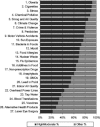Exploring the Determinants of the Perceived Risk of Food Allergies in Canada
- PMID: 23172987
- PMCID: PMC3498839
- DOI: 10.1080/10807039.2012.722857
Exploring the Determinants of the Perceived Risk of Food Allergies in Canada
Abstract
Food allergies are emerging health risks in much of the Western world, and some evidence suggests prevalence is increasing. Despite lacking scientific consensus around prevalence and management, policies and regulations are being implemented in public spaces (e.g., schools). These policies have been criticized as extreme in the literature, in the media, and by the non-allergic population. Backlash appears to be resulting from different perceptions of risk between different groups. This article uses a recently assembled national dataset (n = 3,666) to explore how Canadians perceive the risks of food allergy. Analyses revealed that almost 20% self-report having an allergic person in the household, while the average respondent estimated the prevalence of food allergies in Canada to be 30%. Both of these measures overestimate the true clinically defined prevalence (7.5%), indicating an inflated public understanding of the risks of food allergies. Seventy percent reported food allergies to be substantial risks to the Canadian population. Multivariate logistic regression models revealed important determinants of risk perception including demographic, experience-based, attitudinal, and regional predictors. Results are discussed in terms of understanding emerging health risks in the post-industrial era, and implications for both policy and risk communication.
Figures
Similar articles
-
Exploring Perceptions and Experiences of Food Allergy among New Canadians from Asia.J Allergy (Cairo). 2014;2014:964504. doi: 10.1155/2014/964504. Epub 2014 Jun 4. J Allergy (Cairo). 2014. PMID: 24995022 Free PMC article.
-
"We don't have such a thing, that you may be allergic": Newcomers' understandings of food allergies in Canada.Chronic Illn. 2015 Jun;11(2):126-39. doi: 10.1177/1742395314546136. Epub 2014 Aug 1. Chronic Illn. 2015. PMID: 25085906
-
Frames, claims and audiences: Construction of food allergies in the Canadian media.Public Underst Sci. 2012 Aug;21(6):724-39. doi: 10.1177/0963662510393083. Epub 2011 Mar 1. Public Underst Sci. 2012. PMID: 23832157
-
Canadian Contraception Consensus (Part 1 of 4).J Obstet Gynaecol Can. 2015 Oct;37(10):936-42. doi: 10.1016/s1701-2163(16)30033-0. J Obstet Gynaecol Can. 2015. PMID: 26606712 English, French.
-
Regional Differences in Food Allergies.Clin Rev Allergy Immunol. 2019 Aug;57(1):98-110. doi: 10.1007/s12016-018-8725-9. Clin Rev Allergy Immunol. 2019. PMID: 30612248 Review.
Cited by
-
Exploring Perceptions and Experiences of Food Allergy among New Canadians from Asia.J Allergy (Cairo). 2014;2014:964504. doi: 10.1155/2014/964504. Epub 2014 Jun 4. J Allergy (Cairo). 2014. PMID: 24995022 Free PMC article.
-
Associations with food allergy-related psychological distress in a global sample of adults, children and caregivers.Clin Transl Allergy. 2025 Jun;15(6):e70071. doi: 10.1002/clt2.70071. Clin Transl Allergy. 2025. PMID: 40481258 Free PMC article.
-
CSACI guidelines for the ethical, evidence-based and patient-oriented clinical practice of oral immunotherapy in IgE-mediated food allergy.Allergy Asthma Clin Immunol. 2020 Mar 18;16:20. doi: 10.1186/s13223-020-0413-7. eCollection 2020. Allergy Asthma Clin Immunol. 2020. PMID: 32206067 Free PMC article. Review.
-
Exploring the Concern about Food Allergies among Secondary School and University Students in Ontario, Canada: A Descriptive Analysis.J Allergy (Cairo). 2017;2017:2051916. doi: 10.1155/2017/2051916. Epub 2017 May 16. J Allergy (Cairo). 2017. PMID: 28592973 Free PMC article.
-
Understanding an Environmental Health Risk: Investigating Asthma Risk Perception in Ontario Youth Sport.Int J Environ Res Public Health. 2019 Jun 7;16(11):2033. doi: 10.3390/ijerph16112033. Int J Environ Res Public Health. 2019. PMID: 31181653 Free PMC article.
References
-
- AllerGen. Allergen NCE Inc. 2011. Available from http://www.allergen-nce.ca (accessed May 10, 2011)
-
- Allison PD. Missing Data. Thousand Oaks, CA, USA: Sage Publications Inc; 2002.
-
- Altman DR, Chiaramonte LT. Public perception of food allergy. J Allergy Clinical Immunol. 1996;97:1247–51. - PubMed
-
- Asanin Dean J, Wilson K. My health has improved because I always have everything I need here?: A qualitative exploration of health improvement and decline among immigrants. Social Sci Med. 2010;70(8):1219–28. - PubMed
LinkOut - more resources
Full Text Sources

